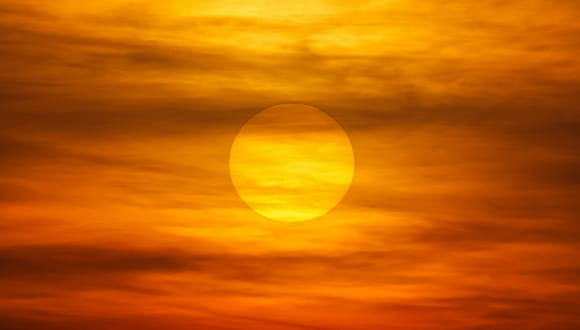June 1 is often considered the unofficial start of summer in Houston. As always, it brings some unwelcome friends to the party: mosquitos, hurricane season, scorching temperatures and Saharan dust. Most active in June, July and August, the dust cloud travels over 5,000 miles to us here on the Gulf Coast, posing health risks, particularly for vulnerable populations.
Dr. Benjamin Saldana, an emergency room doctor at Houston Methodist, says the dust carries disease particles that are most dangerous to the young, elderly and those with asthma, allergies and chronic obstructive pulmonary disease.
"If we don't help people prepare, we will see increased ER visits and people with acute impacts," says Dr. Saldana. "At-risk populations will start having exacerbations."
Dr. Saldana said he expects that as a result of the dust cloud, Houston may see increases in numerous respiratory viruses, but adds there are many things you can do to protect yourself and your most vulnerable loved ones.
First, however, some dust cloud basics.
What is Saharan dust?
Saharan dust is an annual thing in Houston. Every summer, trade winds carry an estimated 180 million metric tons of what's known as the Saharan Air Layer across the Atlantic Ocean, a layer characterized by a mass of very dry, very dusty air. When it arrives, it makes the sky hazy — making it hard to see, much like fog does — while also making sunrises and sunsets look fiery thanks to light scattering.
It has multiple effects, both beneficial and adverse.
On one hand, the dust clouds tend to suppress hurricane activity, keeping sea surface temperatures down and quelling moist air above. Both are key to storm formation.
However, on the other hand, the dust has many adverse effects on the population. Strong winds and fine dust strongly impact humans, especially those with lung illness.
Saharan dust can irritate the lungs
An average grain of beach sand measures in at around 90 microns, or about 0.0035 of an inch. A grain of salt is about 60 microns long, and an average strand of hair has a diameter of 50 microns.
Dust, in general, usually measures about 10 microns. Anything less than that can enter the upper airway of the lungs. Even smaller particles can then enter the air sacs and become an irritant. The Environmental Protection Agency warns of exposure to these microscopic particles called PM2.5 — particles 2.5 microns and smaller that are found in everything from pollution, wildfire smoke and dust storms — due to their ability to enter the bloodstream.
The Saharan dust particles, usually measuring between 1 to 5 microns, are both small enough to enter the lungs and act as irritants but also large enough to act as vessels for even smaller particles, such as respiratory conditons, which usually measure around 0.5 microns.
And when you factor in heat and humidity…
With increased temperatures, the body heats up and the rate of respiration and volume of breath change. People breathe deeper and more rapidly to get needed oxygen, making even those without pre-existing conditions who take in such particles more susceptible to lung irritation.
But vulnerable populations are especially impacted by the dust particles, which can carry disease. The humidity helps the dust particles grab onto more disease particles and carry them around, often directly into the lungs of unsuspecting humans.
Some risks of the heat-humidity-dust combination:
- Chronic obstructive pulmonary disease (COPD)
- Bronchitis
- Covid-19
- Stroke
- Exhaustion
6 ways you can prepare and protect your health
Saharan dust, for many, is a way to capture an Instagram-able sunset, not a major health concern. Still, there are many things you can do to lessen the impacts of the Saharan dust storms and the summer temperatures creeping up this time of the year for yourself and your loved ones.
1. Check your air quality and limit outdoor activity
Review the U.S. Air Quality Index (AQI) in your area to assess your individual risk for going outside. Plan outdoor activities based on the forecast, when both heat and dust levels tend to be generally lower in the mornings and at night.
2. Avoid the heat
Heat exhaustion, also called heat illness, is when a person's body overheats as a result of exposure to hot weather. When temperatures skyrocket, it is important to stay indoors and stay hydrated, especially during midday hours when temperatures are at their highest. When you go outside, be sure to dress for the heat and seek air conditioning or shade as often as possible.
3. Know the signs of heat exhaustion
Common signs of heat-related illness to look out for include dizziness, fatigue, headaches, nausea and vomiting.
4. Avoid dust exposure by using air filters
Exposure to Saharan dust can be minimized by taking proactive steps such as keeping your windows closed or by using an air purifier or HVAC filter in your home.
5. Check on loved ones
Protect vulnerable populations by checking in on their health and avoiding contact if you are sick to prevent passing on any illnesses.
6. Wear a mask or respirator outside
The CDC recommends using an N95 mask or a P100 respirator approved by the National Institute for Occupational Safety and Health (NIOSH) to avoid inhaling microscopic dust particles when outdoor air quality is poor. If you are at higher risk, wearing a mask or respirator is a highly effective form of self-protection.
[Feature Photo: Uday Devineni, 2022]








